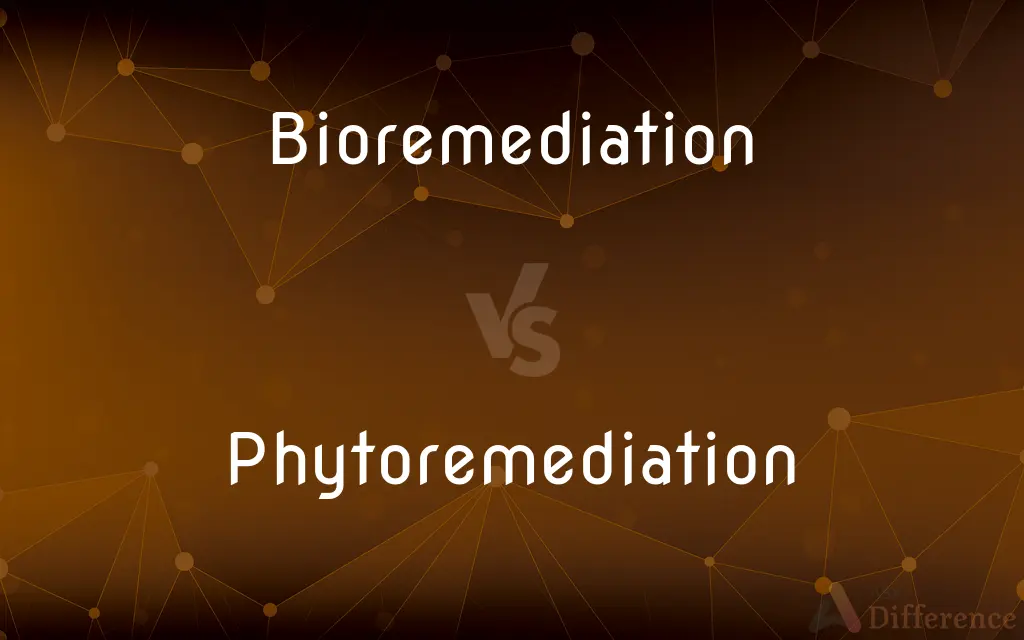Bioremediation vs. Phytoremediation — What's the Difference?
By Tayyaba Rehman — Updated on October 13, 2023
Bioremediation uses microorganisms to degrade pollutants, while phytoremediation employs plants to remove or stabilize contaminants.

Difference Between Bioremediation and Phytoremediation
Table of Contents
ADVERTISEMENT
Key Differences
Bioremediation is an environmentally friendly process that uses living microorganisms to break down or transform harmful substances into less toxic or non-toxic forms. This method, relying largely on bacteria, fungi, and other microbes, offers a sustainable solution to clean up contaminated environments. On the other hand, phytoremediation leverages the natural abilities of plants to absorb, sequester, or transform contaminants from the soil, water, or air. Through phytoremediation, specific plants can be cultivated in polluted areas, acting as biofilters to remove harmful chemicals.
While both bioremediation and phytoremediation are biological methods of treating pollution, the former focuses on microorganisms' capabilities and the latter on plants'.
In terms of application, bioremediation often requires controlled conditions like specific nutrient levels, while phytoremediation might demand a longer timeframe due to plant growth and life cycles.
Comparison Chart
Primary Agent
Microorganisms (bacteria, fungi, etc.)
Plants
Mechanism
Degradation or transformation of pollutants
Absorption, stabilization, or transformation
ADVERTISEMENT
Applications
Soil, water, industrial sites
Soil, water, surface runoff
Timeframe
Can be rapid depending on conditions
Generally longer due to plant growth
Limitations
Needs specific nutrients and conditions
Limited to contaminants plants can handle
Compare with Definitions
Bioremediation
A process using living organisms to neutralize pollutants.
Bioremediation techniques were applied to clean the oil spill.
Phytoremediation
Use of plants to treat environmental pollution.
Phytoremediation was implemented in the lead-contaminated area.
Bioremediation
Microbial cleanup of contaminants.
Bioremediation relies heavily on bacteria's metabolic processes.
Phytoremediation
Plant-based solution to absorb or stabilize contaminants.
The research on phytoremediation is gaining momentum.
Bioremediation
The biological response to environmental pollution.
Bioremediation offers a green alternative to chemical treatments.
Phytoremediation
Growing plants to cleanse soil or water.
Certain wetland plants are ideal for phytoremediation.
Bioremediation
Natural degradation of harmful substances.
The company prefers bioremediation due to its eco-friendly nature.
Phytoremediation
Green approach to pollutant reduction.
Phytoremediation is seen as an aesthetic method of land restoration.
Bioremediation
Treatment of waste using life forms.
Bioremediation was chosen to restore the contaminated land.
Phytoremediation
Using flora for environmental restoration.
Phytoremediation projects are sprouting up globally.
Bioremediation
Bioremediation is a process used to treat contaminated media, including water, soil and subsurface material, by altering environmental conditions to stimulate growth of microorganisms and degrade the target pollutants. Cases where bioremediation is commonly seen is oil spills, soils contaminated with acidic mining drainage, underground pipe leaks, and crime scene cleanups.
Phytoremediation
Phytoremediation technologies use living plants to clean up soil, air, and water contaminated with hazardous contaminants. It is defined as "the use of green plants and the associated microorganisms, along with proper soil amendments and agronomic techniques to either contain, remove or render toxic environmental contaminants harmless".
Bioremediation
The use of biological agents, such as bacteria or plants, to remove or neutralize contaminants, as in polluted soil or water.
Phytoremediation
The planting of trees, grasses, or other vegetation to remove or neutralize contaminants, as in polluted soil or water.
Bioremediation
(biochemistry) The use of biological organisms, usually microorganisms, to remove contaminants, especially from polluted water
Phytoremediation
(biochemistry) bioremediation by the use of plants
Bioremediation
The branch of biotechnology that uses biological processes to overcome environmental problems.
Bioremediation
The branch of biotechnology that uses biological process to overcome environmental problems
Bioremediation
The act of treating waste or pollutants by the use of microorganisms (as bacteria) that can break down the undesirable substances
Common Curiosities
Can phytoremediation handle all contaminants?
No, it's effective for specific contaminants that plants can absorb or transform.
Which method can be visually pleasing in polluted areas?
Phytoremediation, as it involves planting greenery.
What organisms are primarily used in bioremediation?
Bacteria, fungi, and other microorganisms.
Which method uses plants to address pollution?
Phytoremediation.
How do microorganisms help in bioremediation?
They break down or transform harmful substances into less toxic forms.
Does bioremediation always require human intervention?
While naturally occurring, certain conditions might be optimized for effective bioremediation.
Which method is more sustainable?
Both are considered sustainable, but suitability depends on the pollution context.
Is bioremediation a natural process?
Yes, it harnesses natural microbial processes to degrade pollutants.
Are specific plants used in phytoremediation?
Yes, certain plants are chosen for their ability to handle specific pollutants.
Is bioremediation suitable for large-scale pollution?
It depends on the extent of pollution and the specific contaminants involved.
Can bioremediation occur underwater?
Yes, certain microorganisms can treat pollutants in aquatic environments.
Is phytoremediation always slower than bioremediation?
Generally, yes, due to the time needed for plant growth and contaminant uptake.
Do plants used in phytoremediation become toxic?
They can accumulate toxins, so they shouldn't be consumed.
What happens to pollutants during bioremediation?
Microorganisms degrade or transform them into less toxic or non-toxic forms.
Can phytoremediation be used in urban settings?
Yes, especially in areas with contaminated soils or waterways.
Share Your Discovery

Previous Comparison
Mitre vs. Miter
Next Comparison
Gobstopper vs. JawbreakerAuthor Spotlight
Written by
Tayyaba RehmanTayyaba Rehman is a distinguished writer, currently serving as a primary contributor to askdifference.com. As a researcher in semantics and etymology, Tayyaba's passion for the complexity of languages and their distinctions has found a perfect home on the platform. Tayyaba delves into the intricacies of language, distinguishing between commonly confused words and phrases, thereby providing clarity for readers worldwide.













































